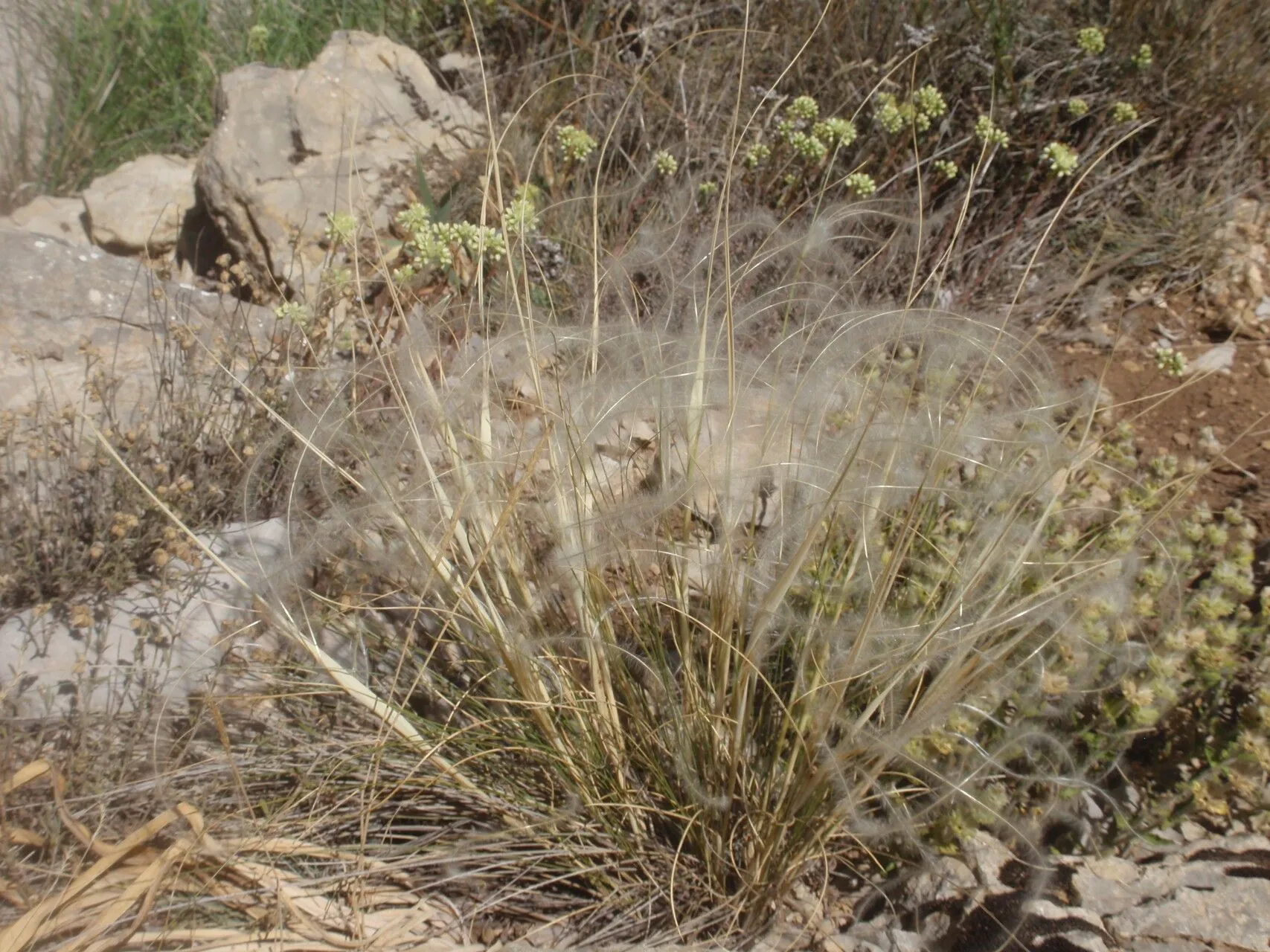
Author: L.
Bibliography: Sp. Pl.: 78 (1753)
Year: 1753
Status: accepted
Rank: species
Genus: Stipa
Vegetable: False
Observations: Europe to Siberia and Pakistan
European feather grass, scientifically known as Stipa pennata, is a remarkable perennial grass species belonging to the Poaceae family. First described by the eminent botanist Carl Linnaeus in his seminal work “Species Plantarum” in 1753, this grass has long captivated botanists and plant enthusiasts alike.
Characterized by its delicate, feather-like seed heads, European feather grass is an elegant addition to various landscapes. The plant forms dense clumps of slender, wiry stems that can reach heights of up to 60 centimeters. These stems bear narrow, linear leaves that are typically rough to the touch due to minute hairs, providing a tactile contrast to the plant’s otherwise graceful appearance.
The most distinguishing feature of Stipa pennata is its inflorescence. The florets are enclosed within long, silvery awns that can extend up to 30 centimeters, giving the plant its feather-like appearance. These awns catch the slightest breeze, creating a mesmerizing spectacle as they sway gently, reflecting sunlight and adding a dynamic element to gardens and natural settings.
Native to a vast range that extends from Europe to Siberia and Pakistan, European feather grass is well-adapted to a variety of climates and soil conditions. It thrives particularly well in well-drained soils and open, sunny locations. Its adaptability makes it a popular choice for both wild and cultivated landscapes, where it can be used to add texture and movement to mixed borders, rock gardens, and prairie-style plantings.
Stipa pennata is not just a visual delight; it also plays an important ecological role in its native habitats. As a hardy grass, it contributes to soil stabilization and provides a habitat for various insects and small animals. Its seeds are adapted for wind dispersal, ensuring that it can easily colonize suitable habitats over wide areas.
Overall, European feather grass is a versatile and resilient species that brings both beauty and ecological benefits to the environments it inhabits. Whether used in naturalistic planting schemes or more formal garden designs, this graceful grass continues to inspire admiration and interest in both botanical and horticultural circles.
Eng: european feather grass
Deu: grauscheidiges federgras
Swe: fjädergräs, äkta fjädergräs
Nob: fjærgras
Nno: fjørgras
En: European feather grass, Feathergrass, Needlegrass, Feather Grass
Ar: عذم ريشي
Ca: Pelaguer plomós
Zh: 针茅鸵
Cs: Kavyl Ivanův
Da: Almindelig Fjergræs
Fi: Höyhenheinä, Unkarinhöyhenheinä
Fr: Stipe pennée, Stipe plumeuse, Cheveu-d’ange, Cheveu-de-Marie-Madeleine, Marabout, Plumet, Stipe penné
De: Echtes Federgras, Federpfriemengras, Flausch-Federgras, Grauscheiden-Federgras, Grauscheidiges Federgras, Mädchenhaargras
Hu: Pusztai árvalányhaj
It: Lino delle fate piumoso, Piumette
Nb: Fjærgras
Nn: Fjørgras
Fa: استپی دائمی
Pl: Ostnica Jana
Ru: Ковыль перистый
Sr: Ковиље
Sv: Fjädergräs, Äkta fjädergräs
Zh-hant: 針茅鴕
Uk: Ковила пірчаста
Taken May 18, 2013 by Tela Botanica − Yoan MARTIN (cc-by-sa)
Taken Jun 29, 2019 by Manuel Portela (cc-by-sa)
Taken May 25, 2018 by Pep Sole (cc-by-sa)
Taken Nov 10, 2022 by S B (cc-by-sa)
Taken May 18, 2020 by Přemysl Valeška (cc-by-sa)
Taken Jun 20, 2020 by Reda Bounab (cc-by-sa)
Taken May 14, 2022 by margarida vila (cc-by-sa)
Taken Jun 17, 2021 by Jacques Zuber (cc-by-sa)
Taken Jun 17, 2021 by Jacques Zuber (cc-by-sa)
Taken May 14, 2022 by margarida vila (cc-by-sa)
Taken Jun 18, 2015 by Tela Botanica − Liliane ROUBAUDI (cc-by-sa)
Taken May 7, 2008 by Tela Botanica − Daniel MATHIEU (cc-by-sa)
Taken May 18, 2013 by Tela Botanica − Yoan MARTIN (cc-by-sa)
Taken Jul 16, 2016 by Miguel A. C. (cc-by-sa)
Taken Jun 17, 2021 by Jacques Zuber (cc-by-sa)
Taken May 21, 2007 by Tela Botanica − Mathieu MENAND (cc-by-sa)
Taken Aug 8, 2019 by PennyT Penny Tait (cc-by-sa)
Taken Jun 8, 2022 by Фёдор Белоусов (cc-by-sa)
Taken Jul 16, 2016 by Miguel A. C. (cc-by-sa)
Taken May 27, 2021 by thierry hanemian (cc-by-sa)
Taken Jun 19, 2021 by Marc CHATELAIN (cc-by-sa)
Taken Aug 13, 2016 by Sophie Mary (cc-by-sa)
Taken Jul 15, 2005 by Photoflora – Jean-Luc TASSET (©)
Taken May 15, 1997 by Photoflora – Benoit BOCK (©)
Taken Jun 4, 2019 by Milan Studnička (cc-by-sa)
Taken May 14, 2021 by Laurence Martin (cc-by-sa)
Taken May 30, 2021 by werner rom (cc-by-sa)
Taken Jan 1, 1970 by Photoflora – L’Abbé COSTE (©)
Taken Jun 15, 2006 by Tela Botanica − Laurent PETIT (cc-by-sa)
Taken Jun 6, 2021 by Ludovic Lavigne (cc-by-sa)
Growth habit: Graminoid
Ph maximum: 7.5
Ph minimum: 7.0
Light: 8
Atmospheric humidity: 3
Soil nutriments: 2
Family: Myrtaceae Author: (F.Muell.) K.D.Hill & L.A.S.Johnson Bibliography: Telopea 6: 402 (1995) Year: 1995 Status:…
Family: Rubiaceae Author: Pierre ex A.Froehner Bibliography: Notizbl. Bot. Gart. Berlin-Dahlem 1: 237 (1897) Year:…
Family: Sapindaceae Author: Koidz. Bibliography: J. Coll. Sci. Imp. Univ. Tokyo 32(1): 38 (1911) Year:…
Family: Asteraceae Author: A.Gray Bibliography: Pacif. Railr. Rep.: 107 (1857) Year: 1857 Status: accepted Rank:…
Family: Fabaceae Author: Medik. Bibliography: Vorles. Churpfälz. Phys.-Ökon. Ges. 2: 398 (1787) Year: 1787 Status:…
Family: Aspleniaceae Author: (Cav.) Alston Bibliography: Bull. Misc. Inform. Kew 1932: 309 (1932) Year: 1932…